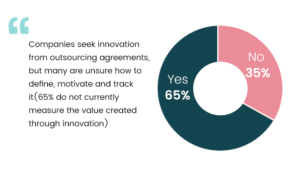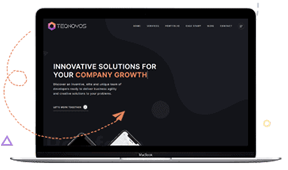Pain Points and After Effects that Clients Face During Outsource The Software Development
(How Teqnovos software development approach address these issues)
Outsource software development is always a favorable option because of its exciting cost savings potential and faster turnarounds. Working with external development teams on software projects, you’re well aware that accessing the right services is not as easy as it may appear. There are many pros of outsourcing software development but cons are not hidden as well. A significant part of our clients came to us after experiencing outsourcing with other providers (not a good experience though). And each new client came with his specific pain-points related to the development process, sometimes its the team, technologies, or the methodologies implemented by the outsourcing provider.

Therefore we came with a detailed blog/information that helps you to understand the reason behind the pain points and as a leading software development company (with more than a decade of experience), how we address these issues and what strategies we usually follow to keep the process automated, smooth and transparent.
Pain Points 1: Clarity on Deliverables & Lack of Documentation
A lot more has been processed before actually kick-starting the software development phase. Before the actual development starts there is a documentation process which divides into three parts:
-
- Requirement gathering.
- Feasibility Analysis
- Functionality Documentation and Deliverables
- Approval
- Utility Flow Diagram
- Prototype
If any step is missing or not approved before the development phase, then it could lead to confusion and developers would end up creating some different product.
Our Solution: Create thorough documentation and deliverables specifications
Detailed software documentation has been prepared by business analysts, project managers, and developers. Business analysts are the single point of communication and developers carry out the feasibility of the project. After rigorous discussion, research and meetings a document has been prepared which contains the complete functionality of the software. This document is kept as a central copy from which each team member understands the functionality and deliverables. After approval via the client, UFD (flowcharts) and a prototype has been carried out for a better understanding of the project. After all these crucial steps the software functionality is locked and to be followed throughout. There are many benefits of detailed and approved documentation delivers:
-
- Enables to set project objectives
- Helps in project planning
- Gives you better hold on to project status
- Facilitates good communication
- Puts governance in place
- Prepares you to handle any complicated risk
- Helps with better resource planning and assignment
- Makes the project development growth visible
- Keeps you more focused
- Helps you to incorporate changes with ease
This one step of accumulating each information about project requirements saves a lot of time and enhances the project success rate. An experienced project manager never underestimates the significance of good documentation. Project management documents, though it takes time but saves time for you from struggling with putting the required actions and making decisions. All the time and effort taken in preparing the documentation is paid off because it enables you to make more efficient and factual decisions.
Pain Point 2: Communication Gap during the development process
Communication issues are one of the most frequently cited issues in outsourcing. But it’s a broad statement, many things fall under this issue. Let’s understand it by taking a closer look at specific reasons of communication problems, and you’ll find threads that lead back to a clear idea about where the improvement requires.
-
- Is it the difficulty handling the detailed documentation needed to transfer project requirements?
- Is it the different time zones?
- The lack of prompt interactions which you normally have with colleagues?
- Trust and Openness
All these discrepancies lead to a different understanding of a project’s requirements by the team members. This can greatly complicate the development process and lead to confusion, misunderstandings that may derail the project or delay key milestones, and other hurdles that guarantee to outsource failure. When it comes to outsourcing S/W development services, it is essential that both parties fully understand each other’s needs and expectations.
Our Solution: Encourage communication and keep space for the buffer
At Teqnovos, we follow the scheduled cycle of daily and weekly meetings, rigorously (offline and online both). In the Agile software methodology, daily standups are by default organized ( Companies who use Agile Methodology are preferred by clients as it brings transparency and daily updates). Not all software companies use Agile, still by assuring all the team members gather for 15 minutes every day and for about an hour every end of the week, development starts to move with speed. Team members who are attending, the timings, and the objective should be noted down in a clear process description. Routine meetings and the process is followed in a structured way that enhances the stable foundation for the outsourcing engagement to streamline communication. Communication problems will begin to solve themselves since people have a daily chance to discuss and align behavior. Teams start finding their solutions (daily project meetings deliver clear data and functionality to follow), without management having to spend days on training and problem-solving sessions. Also, organize a one-hour session at the beginning of a project where teams can discuss the project requirements along with a technical solution to be followed.
Communication challenges can be overcome by using tools for process automation, instant messaging, and video calling. For collaboration, remote working tools such as Basecamp, Asana, and Jira can be used. To overcome the language barrier, businesses in English-speaking countries can outsource to India or other countries where professionals are proficient in English.
Pain Point 3: CyberSecurity and Intellectual Property Concerns
One of the biggest concerns while outsourcing is securing information, business plans, trade secrets shared with the service provider. There’s always the risk of a data breach. Your outsourcing partner may use a part of your software code for the next client. Therefore always secure your information using legal measures. If not handled carefully, one might lose the developed application or its rights.
Our Smart Sourcing Solution and Suggestive Measures
As a leading software development company, we always initialize the project development after signing the NDA (non-disclosure agreement). This agreement contains terms to secure your intellectual property (IP). Confidential information for a business means the designs, ideas, client lists, and other data. The NDA agreement implies not to disclose your data until legally required. Any violations of NDA can lead to legal prosecution as well. Apart from this, your main business contract should contain a clause declaring that your IP would be transferred to you once the project ends. For example, the source code. If you haven’t included explicit statements in your outsourcing contract about the seriousness of protecting your IP and other details & resources, you are unintendedly creating risks. You are leaving the door open for intruders to use your IP, unethically.
Therefore, at Teqnovos we practice modern encryption and access sharing technologies to protect against any data breaches. It results in essentially secure infrastructure which provides reliable protection of information from unauthorized access by third parties.
Outsourcing vendors should use technical protection such as protocols for access to data, physical safeguards to prevent unofficial entry into company premises, and administrative safeguards for regulating operations and employees’ conduct. If service providers are dealing with the data of EU citizens, they should comply with the GDPR (General Data Protection Regulation). If an outsourcing service provider has accepted a development project of a health mobile app for its client in the US, then it should comply with the Health Insurance Portability and Accountability Act (HIPAA).
Furthermore, our premises maintain a high level of employee credibility through Non-Disclosure Agreements that comply with international standards and are designed for the thorough protection of project information. All sensitive information that is passed on to Teqnovos during the SDLC is stored in a secure environment.
Suggestive Measures for Physical and Electronic Protection of Intellectual Property
Pandemic restrains maximum companies to operate via virtual environment using clouds or external servers, therefore it escalates the need for high security to safeguard the data floating all over the internet.
-
- Consider data security as an emergency
- Limit the number of people who have access to the complete information
- Make sure that the outsourcing vendor has a physically secure facility like electronic access control, intrusion detection, video monitoring, etc
- Verify whether the offshore team uses computers without removable media to eliminate the risk of unofficial access to your IP
- Ensure that your employees understand what information they can share and what they cannot.
- Use of firewalls, VPN, encryption, and other measures to restrain security breaches in the electronic environment
- Protect important information, like source code, with passwords and access codes, and make sure that they are not widely available (both onsite and offshore)
- Always maintain an original copy of the source code
- Ensure that any test data being used does not exhibit real information
Legal protection of intellectual property
-
- Find out what country’s legal system will govern and have jurisdiction over contract issues.
- Clarify licensing and source code ownership
- Consider open-source software issues
- Execute individual privacy in the context of database protection obligations (if applicable)
- Reckon non-disclosure and non-compete agreements with the vendor or its team members for keeping important business information private
- State mechanism for possible dispute resolution and arbitration
-
- Put efforts to understand the legal system and culture of both countries
- Discover how IP rights enforcement works in the provider’s country
- Negotiate a clearly stated contract that specifically addresses business knowledge and IP-related issues and makes the vendor responsible for the actions of its employees. This will enable to ensure suitable protection, avoid disagreements and avoid litigation
- Clearly state compliance audit procedures before getting engaging in outsourcing relationships
Pain Point 4: Budgeting, Time Zone, and Delays
Vendors may find disappointment with upcharges in the project at a later development stage. This can result in unexpected issues, and communication issues, among other issues. Many companies are running on fewer budgets than they anticipated due to pandemic shutdowns and lost business. Now, they’re bound to figure out how to do “more” with very little. Sometimes inaccurate cost estimates at the beginning of the project can lead to wasted or misallocated resources. Ultimately, your project can be over-budget, costing much more than your project leadership planned for. Usually, software development moves swiftly to keep pace with user expectations and touching goals. Unfortunately, delays sometimes happen in software projects. Unexpected, unplanned difficulties can occur: you may lose a core team member, or you might encounter communication problems within your team. A delay on one sprint can then push the next sprint back and set your entire schedule off track. Quality is another pain point, the presence of bugs and other defects in your final product will make it flawed at best or ruin your reputation at worst. Then comes the talent issue, companies find great talent but the cultural barrier becomes an imminent challenge. When businesses outsource their projects to offshore destinations, they have to cope with two types of cultural differences – corporate and regional differences. Corporate differences arise because outsourcing involves dealing between two different organizations. Regional differences arise because the business and the outsourcing services provider are located in different countries.
Our Approach and Solutions
To avoid the above-stated issues, discuss the potential scenarios with the outsourcing team before they start the project, so the client is fully aware of how several circumstances would arise in the future and that can affect the cost too. A client can reduce the risk of misjudging overall costs by doing everything you can to determine costs upfront and check in on the numbers during the project as you achieve project milestones to see how your budget is matching up with expenditure for each part of the project.
Flexible Budget: A good project plan should assume some budget flexibility, ideally accounting for potential cost increases or changes.
Find price ranges: Discover potentially high-budget areas of your project at an early stage along with a range that includes worst-case outlines.
Gartner’s report reveals analysts recommend that CIOs respond by re-evaluating business cases to make better use of investments and reallocate the internal workforce to prioritize digital shift.
For example, if you’re no longer renting office space, you might use the money you’ve saved to make strategic hires, launch a new product, partner with an outsourcing company, etc.
To overcome quality issues it’s necessary to assure that your development team employs a thorough, rigorous quality assurance (QA) process to help you rest assured that your project has been carefully screened and properly functional.
QA testing can’t provide complete assurance of the absence of bugs, but it can catch as many as feasible. It’s an important step to take forward that enables you to deliver a quality product.
It’s essential to understand that some delays are inevitable, such as when the client adds more requirements or otherwise changes the concept of the project. Being clear and informative and trying to minimize disruptions will keep the project on track.
High-quality software is what every project team looking for, but quality doesn’t happen by chance. Quality assurance is a necessary part of making sure your software is successful on release day. Cutting quality assurance out to meet deadlines usually erupts and leads to more work and more delays.
In other words, you need a formal process for quality assurance and you also need an engineering team that’s committed to it.
Your software project needs conscientious planning and a commitment to following best practices to avoid common development pitfalls. Throughout your project, keep up the communication among your team and encourage everyone to follow your processes.
To accomplish timeliness, the best way to set expectations is to break down the project into smaller parts. At Teqnovos we invest a good amount of time in milestone and delivery set up, dates, and specs, and then we’ll do weekly calls to make sure that things are moving along as planned. It is apparent, things won’t always go as they are planned! And so when that happens it’s best to have clear communication to lessen the risk and damage of project impediments.
Pain Point 5: Ever Changing Technology Trends
In the IT industry, the lifespan of a craft, technique, or process seems to be around three to four years. By the time you build an application and start to taste its success in the marketplace, the techniques used to develop it may already be obsolete. To cope with this extreme shift in innovation, you have to stay up-to-date with changing industry standards and requirements. Even as the pressure rises to do more with less, faster than ever before, you have to discover time to invest in keeping your skills up to date.
Our Solution: At Teqnovos, we practice adaptability, agility, and flexibility. We are adopting new technology infrastructure and encouraging employees to keep updated with ever-changing technology trends. We invest in training programs for employees so that they can learn the disruptive technology trends. Suggestive measure for clients to work directly with the developers of other software your users rely on to create integrated software packages that benefit both companies and end-users.
A technology architect is always there to assist both parties (vendor and outsourcing party), he always suggests the best technical routes and preventive measures to be followed, which are also meant for future years.
Last Words
The above-stated information reveals that outsourcing comes with intricate challenges that can make it difficult for businesses/vendors to adopt it. But fortunately, there are ways available to easily overcome these challenges so that the beneficial practice of outsourcing can be readily used by businesses of all sizes. The risks discussed in this article are common for businesses that are delegating IT services for the first time or have faced bad experiences previously. To gain more control over software development and make wiser decisions, you need smart sourcing. It’s a well-structured and valuable approach that helps you develop a partnership with the vendor, which offers you favorable results.
We at Teqnovos, possess rich experience and expertise working in remote situations with remote teams and very well understand the pain points of outsourcing and that is why we follow policies for streamlining the process.
Are you looking for IT Partner or software development company that understands your pain and suggests you excellent technical route? Reach out to us and let us take away your pain. Let us build exceptional technology products, together!
















